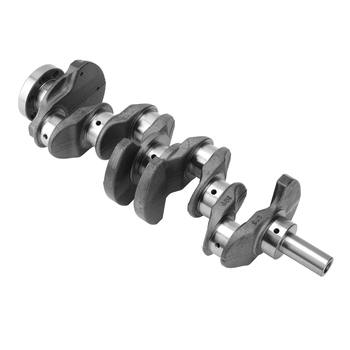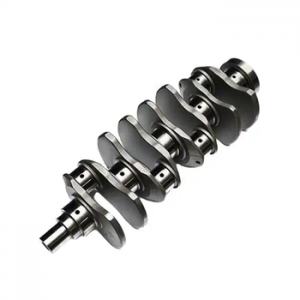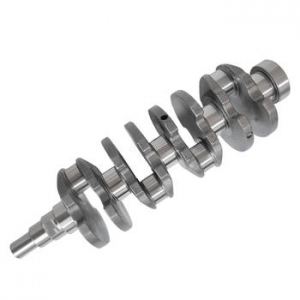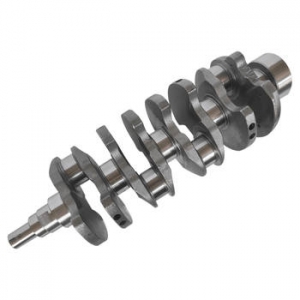Power Your Business: A Deep Dive into Sourcing Wholesale Crankshafts
In the intricate dance of internal combustion, few components carry as much weight—both literally and figuratively—as the crankshaft. It's the backbone of the engine, the master translator that converts the violent, linear explosions of the pistons into the smooth, rotational force that ultimately turns the wheels. For any engine builder, auto repair shop, or performance tuner, a reliable supply of high-quality crankshafts isn't just a convenience; it's the lifeblood of the business. This is where the world of wholesale crankshafts opens up a realm of opportunity, offering a strategic advantage that can define your profitability and reputation.
Frankly speaking, navigating the wholesale market can feel daunting. It's a landscape filled with technical jargon, varying quality standards, and a dizzying array of suppliers. But understanding this market is the key to unlocking significant cost savings, ensuring consistent quality for your builds, and positioning your business as a leader. This guide is designed to be your roadmap, cutting through the noise to provide clear, actionable insights into sourcing the best crankshafts for your needs.
The Heart of the Engine: Understanding Crankshaft Fundamentals
Before we dive into the logistics of purchasing, it's crucial to have a solid grasp of the component itself. After all, how can you buy with confidence if you don't know exactly what you're looking for? Have you ever stopped to truly consider the immense stress a crankshaft endures? It's a marvel of engineering.
What is a Crankshaft and Why is it So Crucial?
At its core, a crankshaft is a shaft with a series of cranks and crankpins to which the connecting rods are attached. As the pistons move up and down in the cylinders, they push on the connecting rods, which in turn rotate the crankshaft. This rotational force is then transferred to the flywheel, transmission, and eventually the wheels. It's the primary component responsible for an engine's stroke—the distance the piston travels in the cylinder—which directly influences engine displacement and torque characteristics.
A crankshaft's job is brutal. It must withstand incredible torsional (twisting) and bending forces, all while spinning at thousands of revolutions per minute. A failure here isn't just a minor issue; it's catastrophic, often leading to the complete destruction of the engine block. This is why material choice, manufacturing process, and overall quality are non-negotiable.
Common Materials and Manufacturing Processes
The properties of a crankshaft are largely determined by what it's made of and how it's formed. In my experience, understanding these differences is the first step in matching a part to its intended application.
- Cast Iron/Nodular Iron: This is the most common material for standard OEM and many aftermarket replacement crankshafts. Casting involves pouring molten iron into a mold. It's a cost-effective process that produces a reliable part for stock or mildly modified engines. The resulting grain structure is strong but can be brittle under extreme stress.
- Forged Steel: Forging involves taking a solid billet of steel (often alloys like 4340 chromoly) and hammering or pressing it into shape at extreme temperatures. This process aligns the grain structure of the metal, resulting in a part that is significantly stronger and more resistant to cracking than a cast equivalent. Forged cranks are the standard for high-performance street engines and most forms of motorsport.
- Billet Steel: This is the pinnacle of crankshaft manufacturing. A billet crank is CNC-machined from a solid, forged bar of high-grade steel. There are no compromises in the grain structure, and the design can be optimized for maximum strength and minimum weight. Billet cranks are reserved for the most extreme applications—think professional drag racing, tractor pulling, and multi-thousand horsepower builds.
Signs of a Failing Crankshaft
Recognizing a crankshaft on its last legs can save an engine. Key symptoms your customers might report, or that you might find during a teardown, include:
- Engine Knocking: A deep, rhythmic knocking sound from the bottom end of the engine is a classic sign of worn main or rod bearings, which can quickly lead to crankshaft damage.
- Excessive Vibration: If the crankshaft is bent or out of balance, it will cause severe engine vibrations that worsen with RPM.
- Visible Cracks or Scoring: During an engine rebuild, a meticulous inspection using methods like magnafluxing can reveal stress cracks that are invisible to the naked eye. Scored or damaged journal surfaces are also a major red flag.
- Metal Shavings in Oil: Finding glitter in the engine oil during a change is a tell-tale sign of bearing material breaking down, indicating severe wear and potential crankshaft damage.

The Wholesale Advantage: Why Buying in Bulk Makes Sense
For a business, sourcing parts one at a time is inefficient and expensive. Shifting your procurement strategy to purchasing wholesale crankshafts directly from distributors or manufacturers is a game-changer. It's a move from being a retail customer to a business partner.
The Economics of Buying Wholesale Crankshafts
The most obvious benefit is, of course, the cost. When you buy in bulk, you bypass several layers of the retail supply chain, leading to a significantly lower per-unit price. This cost saving can be passed on to your customers to make your services more competitive, or it can be absorbed to drastically improve your profit margin on engine builds and major repairs. To be honest, this is often the single biggest factor that allows a performance shop to scale its operations.
Ensuring Consistent Quality and Supply
Working with reputable bulk crankshaft suppliers provides a level of consistency that's hard to achieve with one-off purchases. When you establish a relationship, you can count on receiving parts that meet a specific quality standard every time. This predictability is invaluable. It means fewer surprise defects, less time spent on returns, and a more streamlined workflow in your shop. A steady supply chain also means you can quote jobs and schedule work with confidence, knowing the critical components will be on hand when you need them.
Expanding Your Inventory and Service Offerings
Buying wholesale allows you to stock a wider variety of crankshafts. Instead of only ordering a specific crank for a specific job, you can afford to keep popular models for common engines (like the Chevy LS, Ford Coyote, or Honda B-series) on your shelves. This not only speeds up your turnaround time but also positions you as a knowledgeable, well-equipped specialist. You can cater to a broader range of customers, from those needing a simple OEM replacement to enthusiasts seeking high-performance crankshafts for sale as part of a full-on race build.
Navigating the Market: How to Identify High-Quality Wholesale Crankshafts
Not all crankshafts are created equal, and this is especially true in the vast aftermarket. The lower price of wholesale purchasing is only a benefit if the quality is there. Here’s what to look for to ensure you're getting a top-tier product.
Key Quality Indicators to Look For
When evaluating a potential crankshaft, you need to look beyond the price tag. Many experts agree that these are the critical factors:
- Material Certification: A reputable manufacturer will be able to provide documentation on the material used, such as a certificate for 4340 forged steel. This is your first guarantee of strength.
- Machining and Tolerances: Check the journal surfaces. They should be perfectly round, micro-polished, and free of any chatter marks. Tight tolerances on journal diameter and concentricity are essential for proper bearing clearance and long engine life. * Fillet Radii: The small, curved transition where the journal meets the counterweight is a high-stress area. A properly designed crankshaft will have a generous, well-machined fillet radius to distribute this stress and prevent cracking.
- Balancing: Ask if the crankshaft is balanced and to what specification. Most quality aftermarket cranks are internally balanced to a tight tolerance (e.g., +/- 1 gram), which is crucial for a smooth-running, high-RPM engine.
Cast vs. Forged vs. Billet: Which is Right for Your Needs?
Matching the crankshaft type to the engine's intended use is paramount. It’s a classic case of "right tool for the right job."
For a daily driver or a standard engine rebuild where the vehicle will operate within its factory limits, a high-quality cast crankshaft is perfectly adequate and the most cost-effective solution. It provides OEM-level reliability and performance.
When you step into the world of performance—think turbochargers, superchargers, nitrous, or high-RPM naturally aspirated builds—a forged steel crankshaft becomes a necessity. Its superior tensile strength and ductility can handle the significantly increased cylinder pressures and rotational forces without failing. This is the sweet spot for the vast majority of performance and enthusiast builds.
A billet crankshaft is the ultimate choice, but it's often overkill. You only need to specify a billet crank for all-out racing applications where the engine will be pushed to its absolute mechanical limits and cost is a secondary concern. The precision of aftermarket crankshaft manufacturing using CNC technology for billet parts is truly remarkable.

Decoding Specifications: Stroke, Journals, and Balancing
When you look at a spec sheet, you'll see terms like stroke, main journal diameter, and rod journal diameter. The stroke is the distance from the centerline of the main journals to the centerline of the rod journals, multiplied by two. A longer stroke (a "stroker" crank) increases engine displacement, typically boosting torque. The journal diameters must match the engine block and connecting rods you plan to use. Finally, understanding if a crank is internally or externally balanced is critical. Internally balanced cranks have all counterweights on the crank itself, while externally balanced cranks rely on weight on the flywheel and harmonic balancer. You cannot mix and match these components.
Finding the Right Partner: Vetting Bulk Crankshaft Suppliers
Your supplier is more than just a vendor; they are a partner in your success. Choosing the right one is arguably the most important step in this entire process.
Characteristics of a Reliable Supplier
A trustworthy supplier isn't just the one with the lowest price. Look for a partner who exhibits these qualities:
- Industry Experience and Reputation: How long have they been in business? What do other shops and builders say about them? A long track record is often a sign of reliability.
- Technical Expertise: Can their sales team answer detailed technical questions about their products? A good supplier employs people who understand engines, not just part numbers.
- Transparent Quality Control: They should be open about their QC processes, from material sourcing to final inspection and balancing.
- Robust Warranty and Return Policies: Even the best manufacturers have occasional defects. A good supplier will stand behind their product with a clear and fair warranty.
- Reasonable Minimum Order Quantities (MOQs): Ensure their MOQ aligns with the scale of your business. Some wholesalers are geared towards massive distributors, while others are happy to work with independent shops.
Questions You MUST Ask a Potential Supplier
Don't be afraid to interview a potential supplier. Arm yourself with these questions:
- What specific quality control checks are performed on each crankshaft before it ships?
- Can you provide material traceability reports or certifications for your forged and billet cranks?
- What is your warranty process if I receive a defective part?
- Do you offer technical support for application-specific questions?
- What are your shipping and freight policies for bulk orders?
- Do you offer tiered pricing based on volume?
Their answers—and their willingness to answer—will tell you a lot about the kind of partner they will be.
The Pitfalls of Sourcing from Unverified Channels
It can be tempting to chase the absolute lowest price on online marketplaces or from unknown overseas sellers. It's worth noting, however, that this path is fraught with risk. You may encounter counterfeit parts masquerading as reputable brands, parts with poor machining and hidden defects, or materials that don't meet spec. When that "too good to be true" crankshaft fails and destroys a customer's engine, the initial savings will be a distant memory. Stick with established, verifiable bulk crankshaft suppliers who have a reputation to protect.
The Future of Crankshafts and the Wholesale Market
The automotive world is always evolving, and crankshafts are no exception. Staying aware of trends is key to keeping your business competitive.
Innovations in Materials and Design
Engineers are constantly pushing for lighter, stronger, and more efficient components. We're seeing advancements in steel alloys, the use of friction-reducing surface coatings, and designs with more intricate counterweighting to reduce mass without sacrificing strength. These innovations are especially prevalent in the high-end aftermarket, where every ounce and every bit of durability counts.
The Growing Demand for Performance and Aftermarket Parts
Interestingly enough, as mainstream cars move towards electrification, the passion for internal combustion engines in the enthusiast community is stronger than ever. The restoration, hot-rodding, and motorsport markets are thriving. This creates a sustained and growing demand for high-quality components. Businesses that specialize in this niche and can provide top-tier parts like forged crankshafts are well-positioned for future growth.
Ultimately, building a successful business around engine work requires a foundation of quality components. By understanding the technology and mastering the art of sourcing wholesale crankshafts, you're not just buying parts; you're investing in your business's reputation, profitability, and future. It’s about building engines that last, delivering performance that thrills, and creating a loyal customer base that trusts your expertise.
For more detailed information, please visit our official website:Wholesale crankshafts
About the author: Marcus 'Crank' O'Connell is a seasoned engine builder and parts sourcing specialist with over 25 years of experience in the high-performance automotive industry. After a decade of building race-winning engines for drag and road course teams, he transitioned his focus to consulting for performance shops. Marcus specializes in helping businesses optimize their supply chains for critical engine components, ensuring they achieve the perfect balance of quality, performance, and cost-effectiveness in every build.
 Crankshaft Distributor: The Un
Crankshaft Distributor: The Un
 The Ultimate Guide to Sourcing
The Ultimate Guide to Sourcing
 Power Your Business: A Deep Di
Power Your Business: A Deep Di
 Choosing the Right Crankshaft
Choosing the Right Crankshaft
